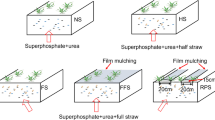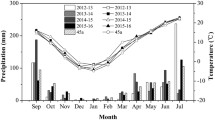Abstract
To study the long term effects of rice straw management practices in a wheat-rice rotation, experiments were started from the dry season (Nov–May) of 1984 to wet season (July–Nov) of 1989. Each year, six straw management practices, viz. control (C), straw incorporation (SI), straw mulch (SM), straw burning (SB), animal manure incorporation (AM), and straw and animal manure incorporation together (SI+AM) were imposed to wheat crop and their subsequent residual effect was studied on the following rice crop under three levels of N, viz. 0, 60 and 120 kg N ha−1. The rate of straw and animal manure used was 5 t ha−1 on dry weight basis.
The wheat yield and N uptake did not vary significantly under control and SB throughout the experimental period. But, the production level of wheat and N uptake were consistently higher under AM and SM over these two treatments. The SI+AM which had significantly lower wheat yields and N uptake over the AM during the first crop, became equal to that of AM and SM during the second and third crops, and out yielded these two treatments from the fourth crop onward. Straw incorporation which produced wheat yield and N uptake even less than control and SB during the first two crops, resulted in wheat yield and N uptake equivalent to AM and SM from the fourth crop onward.
None of the straw management practices had residual effects on the yields and N uptake during the first rice crop, except SM which reduced the rice yields and N uptake in the first two crops. However, AM and SI+AM in the second crop; AM, SI+AM and SI in the third crop; and AM, SI+AM, SI and SM from the fourth crop onward had significant and positive residual effects on rice yields and N uptake. Among these four treatments, SI+AM produced residual effects which were significantly higher than the remaining three treatments. Considering the production levels of wheat and rice, SI+AM treatment resulted in savings of 60 kg N ha−1 each for wheat and rice.
After five years of experimentation, the maximum soil build-up of organic carbon; available N, P and K; and DTPA-extractable Zn, Cu, Fe and Mn was observed under SI+AM, followed by AM and SM and it was minimal under SB and control treatments. The treatments of AM and SI+AM also resulted in a high percentage of water-stable aggregates of 70.25 mm in diameter (80.9%), larger mean weight diameter (0.82 mm), higher porosity (54.2%) and lower bulk density (1.19 Mg m−3).
Similar content being viewed by others
References
Amrasiri SL and Wickremasinghe K (1977) Use of rice straw as a fertilizer material. Tropical Agriculturist 133: 39–49
Beye G, Taure M and Arial G (1978) Effect of incorporating straw on the physicochemical properties of paddy soils of lower Casamance and on the development of rice. Agronomie Tropicale 33: 381–389
Black CA (1965) Methods of Soil Analysis, Part 2. Am Soc Agron, Wis
Boekel P (1963) The effect of organic matter on the structure of clay soils. Netherlands, J. Agric. Sci. 11: 250–263
Bryan RB (1971) The efficiency of aggregation indices in the comparison of some English and Canadian soils. J Soil Sci 22: 166–178
Chandrasekaran S and Yoshida T (1973) Effect of organic acids transformations in submerged soils on the growth of rice plant. Soil Sci Plant Nutr 19: 39–45
Curtis RO and Post BW (1964) Estimating bulk density from organic matter content in some forest soils. Soil Sci. Soc Am Proc 28: 285–286
De Datta SK and Barker R (1978) Land preparation of rice soils. In: Soils and Rice. International Rice Research Institute, pp 623–648. Los Banos, Philippines
Gaur A (1979) Organic recycling. Prospects in Indian agriculture. Fert News 24: 49–291
Jackson ML (1967) Soil Chemical Analysis. Prentice Hall, Inc Englewood
Kawata SV, Seegima M (1976) The effect of compost application to the paddy yield and on some physical properties of sandy loam soils of Hissar. J Indian Soc Soil Sci 23: 380–383
Kanivets II and Fomin YA (1978) The use of straw in agriculture of the arid steppe zone of northern Kazakhasthan, Izvestiya Acad Nank SS 12. Biologich eskaya 4: 534–540
Katyal JC (1977) Influence of organic matter on chemical and electrochemical properties of some flooded soils. Soil Biol and Biochemistry 9: 259–266.
Kumuzawa K (1982) Beneficial effects of organic matter on rice growth and yield in Japan. In: International Conference on organic matter and Rice. International Rice Research Institute, Los Banos, Philippines
Lal R (1973) Soil temperature, Soil moisture and maize yield from mulched and unmulched tropical soils. Plant and soil 40: 129–143
Lindsay WL and Norvell WA (1978) Development of a DTPA soil test for zinc, iron, manganese and copper. Soil Sci Soc Am J 42: 421–428
Low AJ (1972) The effect of cultivation on the structure and other physical characteristics of grasslands and aerable soils. J Soil Sci 23: 363–380
Modgel SC, Sharma HL and Singh MP (1982) Studies on the utilization of crop residues and organic wastes in rice wheat cropping systems in North Western Himalayas. In: Transmations of 12th International Congress of Soil Science, p 204. New Delhi
Nakada H (1980) Mathematical Statistics analysis of long term application of three materials and compost on level and productivity. Singha Agricultural Experiment station special Bulletin 13
Oh WK (1978) Effect of incorporating organic materials on paddy soils. In: Nitrogen and Rice, International Rice Research Institute, pp 435–449. Los Banos, Philippines
Olsen SR, Cole CV, Watanabe FS and Dean LA (1954) Estimation of available phosphorus in soils by extraction with sodium bicarbonate. USDA Circ 939
Ponnamperuma FN (1982) Straw as a source of nutrients for wetland rice. In: Int Conf on organic matter and Micl, Int Rice Res Inst. Los Banos, Philippines
Saini GR (1966) Organic matter as a measure of bulk density of soil. Nature 210: 1295–1296
Sinha MK (1975) Effect of straw application on yield and phosphorus nutrition of crops. Plant and Soil 43: 537–545
Subhiah BV and Asija GL (1956) A rapid procedure for the estimation of available nitrogen in soils. Curr Sci 25: 259–260
Tanaka A (1979) Methods of handling of cereal crop residues in Asian countries and related problems. ASCPAC Extension Bull 43: 29
Van Bavel CHM (1949) Mean weight diameter of soil aggregate as a statistical index of aggregation. Soil Sci Soc Am Proc 14: 20–23
Wade MK and Sanchez PA (1976) Mulching and green manuring studies. In: Agronomic Research on Tropical Soils. pp 166–180. Ann Rep Carolina State Univ, Raleigh NC
Williams WA, Morse MD and Buckman JR (1972) Burning versus incorporation of rice residues. Agron J 64: 467–468
William RJB and Cooke GW (1961) Some effect of farm yard manure and of grass residues on soil structure. Soil Sci 92: 30–39
Yoder RE (1936) A direct method of aggregate analysis of soils and a study of the physical nature of soil erosion. J Am Soc Agron 28: 337–351
Author information
Authors and Affiliations
Rights and permissions
About this article
Cite this article
Verma, T.S., Bhagat, R.M. Impact of rice straw management practices on yield, nitrogen uptake and soil properties in a wheat-rice rotation in northern India. Fertilizer Research 33, 97–106 (1992). https://doi.org/10.1007/BF01051164
Received:
Accepted:
Issue Date:
DOI: https://doi.org/10.1007/BF01051164




